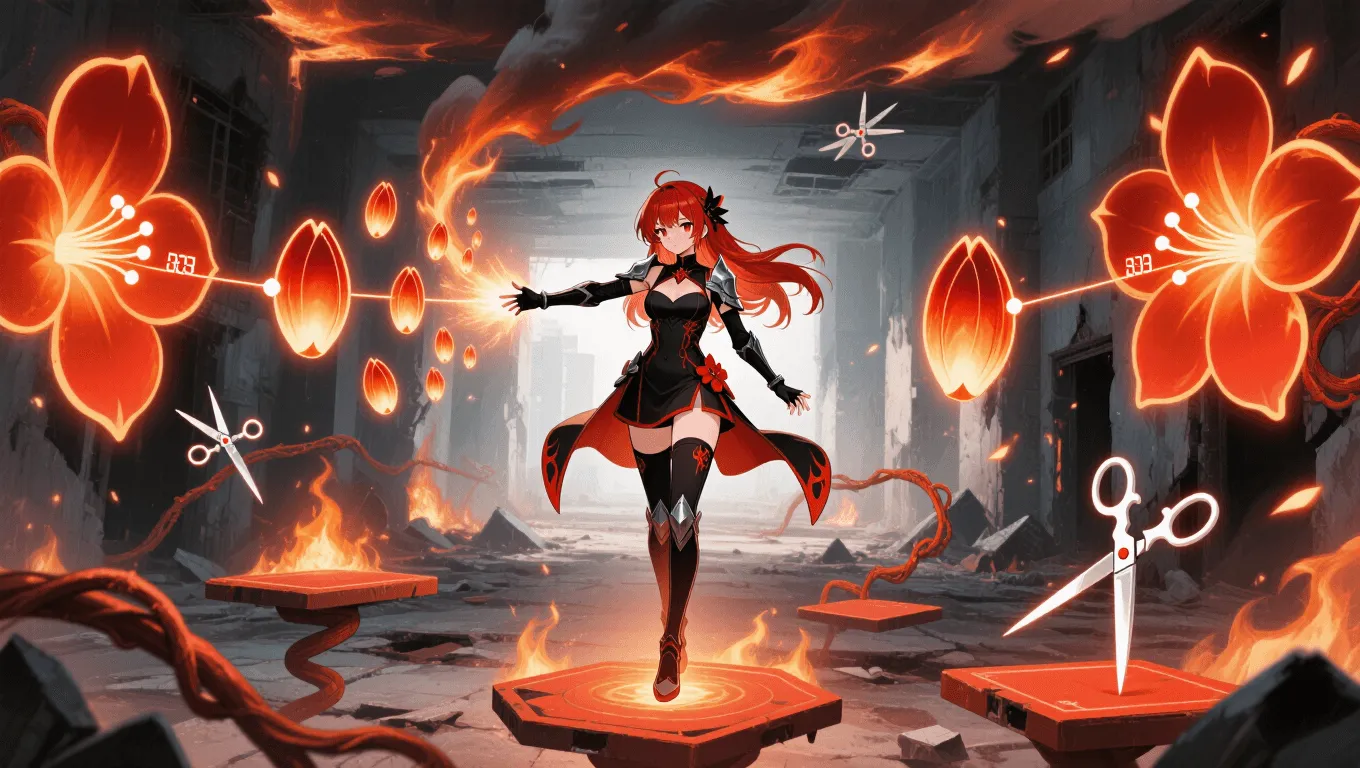Blazing Blossom (Superpower Guide)

Blazing Blossom Video Demo 🎬
Table of Contents
Blazing Blossom is a hybrid elemental ability that fuses fire manipulation with botanical control. Wielders bloom petals, vines, and seeds that ignite on command—creating living flames that move, shield, and strike like a garden made of fire. Because the main keyword describes both ignition and growth, Blazing Blossom is often grouped with floral pyrokinesis, ember-petal constructs, and incendiary pollen techniques. This guide breaks down what the power is, how it works, combat applications, limits, counters, and synergistic combos, plus notable users and analogs. For a broader look at related abilities, check the evolving entries in the Superpower Wiki or experiment with our Random Superpower Generator.
What Is Blazing Blossom
Blazing Blossom is the power to generate, shape, and command plantlike constructs composed of flame and heat-reactive “biomass.” At its core, it merges thermokinesis (heat control) with chlorokinetic patterns (growth, branching, and blooming). Instead of summoning ordinary fire, the user “grows” flame as petals, fronds, seedpods, and vines that exhibit plantlike behaviors: reaching for fuel, unfurling toward oxygen, and clustering into floral shields or fields.
Key ideas that define the superpower:
-
Pyro-botanical constructs: Fire is organized into botanical forms—petal fans, ember vines, pollen clouds—that behave predictably and can be repositioned.
-
Heat-bloom growth: Flames “bloom” outward from a seedpoint, allowing quick area coverage and shape control (arches, lattices, wreaths).
-
Combustible biomimicry: The constructs mimic plants but are made of flame, cinders, ashflow, and heated air. Some wielders can lace real flora with ignition lines to propagate controlled burns.
-
Precision ignition: Sparks and “seeds” can be planted in advance, triggered later for traps or synchronized detonations.
Common synonyms and related keywords include floral pyrokinesis, ember petal manipulation, cinder garden creation, heat bloom shaping, and incendiary vine control.
Core abilities of Blazing Blossom
Ember Petal Generation
Users create petal-like flames that spin, drift, or lock into place. Petals can act as deflectors, absorbing and shedding kinetic energy by vaporizing air and creating pressure cushions.
Scorchvine Control
Ribbonlike flame-vines lash, coil, and tether targets. They can grapple opponents or stitch together fiery barriers across choke points.
Pollen Flare Clouds
Microscopic ember “pollen” hangs in the air as a shimmering haze. On a cue—breath, clap, or snap—the cloud flares to blind, mark, or scorch. Advanced users modulate heat to create nonlethal dazzles or flash detonations.
Bloom Burst Grenades
Seedlike fire-nodes can be thrown or planted. When triggered, each “seed” blossoms into a radius-limited flower of flame, ideal for corners, doorways, and ambushes.
Cinder Canopy Shields
Overlapping petals form a floral dome of thin, cycling flame layers. This canopy dissipates projectiles, melts ice-based restraints, and redirects small-arms fire by heat shimmer and lift.
Wildfire Step
A mobility trick: the user lays down a petal trail and rides the uplift of hot air for quick dashes or short hops. With mastery, this becomes a midair flame-lily platform to change direction quickly.
Thermal Botany of Real Plants
High-level wielders can lay ignition filaments through actual foliage, causing leaves to smolder safely or burst in a controlled chain, creating firebreaks or guided burns without uncontrolled spread.
Application / Tactical Advantages in Combat
Area Denial and Zone Control
A drifting pollen flare forces enemies to reposition. Scorchvine lattices narrow approach lanes. Bloom burst seeds enforce no-go zones around objectives, stairwells, or extraction points.
Crowd Management with Graduated Force
Because heat can be modulated, Blazing Blossom supports scalable responses: low-heat dazzles for warnings, warm updrafts to shove drones off course, or full-bloom bursts for hard stops.
Counter-Stealth and Marking
Ashfall from petal fans dusts invisible foes or cloaked tech, revealing outlines. Ember pollen sticks to suits and bots, glowing under heatlike signatures for target tracking.
Anti-Projectile and Anti-Swarm Defense
Cinder canopies and petal fans deflect microdrones, slow incoming shrapnel, and warp the path of bullets at oblique angles via thermal shimmer, buying crucial milliseconds.
Environmental Leverage
In brush, parks, or greenhouses, the power amplifies—real plants become conduits for safe, segmented burns that corral targets without catastrophic spread when used responsibly.
Level: Level 1 🏙️, Level 2 🌇, Level 3 🌃
Level 1 🏙️ — Spark Gardener

-
Scope: Room-scale effects; simple petal shields; short scorchvines (2–3 meters).
-
Precision: Can place 2–4 bloom seeds; small pollen cloud for brief glare.
-
Mobility: Short Wildfire Step bursts for dodges or hops.
-
Focus: Learning heat modulation to avoid collateral damage; safe training in controlled arenas.
Level 2 🌇 — Fire Florist

-
Scope: Building-floor coverage; persistent cinder canopies; vines that tether midweight targets.
-
Precision: 5–12 linked bloom seeds with staggered timers; shaped-petal walls with windows.
-
Mobility: Flame-lily platforms allow multi-directional changes and midair feints.
-
Utilities: Ashfall marking, anti-drone shears, heat-bloom corridors for evacuations.
Level 3 🌃 — Cinder Botanarch

-
Scope: Block-level zoning; split-control over multiple fronts; rapid regrowth of burned petals.
-
Precision: 20+ seeds synchronized to detonate in choreographed petal cascades.
-
Mobility: Continuous Wildfire Step chains; limited thermal gliding on rising columns.
-
Mastery: Threading ignition through real flora with surgical control; sculpting nonlethal heat lenses to disable tech without open flame.
Limitations of using the Blazing Blossom
-
Oxygen and Ventilation Dependence: Petal flames underperform in sealed, low-oxygen spaces or high-altitude vacuums. Pollen flares fail without adequate air mixing.
-
Fuel and Thermal Budget: Large constructs demand sustained heat input. Overextension leads to thermal fatigue, slowed reaction time, and heat haze obscuring the user’s own vision.
-
Moisture and Precipitation: Heavy rain, fog, or mist quenches petals and collapses canopies. Saturated foliage resists filament threading and delays ignition.
-
Collateral Risk: Even with modulation, thermal updrafts can trigger sprinklers, damage sensors, or stress structures. Ethical and tactical doctrine should emphasize controlled burns and clear safety lines.
-
Line of Sight and Microcontrol: Complex shapes require consistent visual or sensory focus; smoke, dazzles, or psychic disruption break petal coherency.
-
Heat-Resistant Materials: Ceramics, ablatives, or foam retardants shrug off weaker blooms, forcing the user to stack effects or switch tactics.
-
Legal and Environmental Constraints: Many jurisdictions restrict open flame deployment outside emergencies. Coordinating with responders and adhering to fire codes is essential.
-
Cooldown Windows: Regrowing cinder canopies or relaying ember lattices introduces brief vulnerability gaps.
Weakness against what other superpowers
-
Hydrokinesis / Weather Control: Directed water jets, heavy rain calls, or humidity spikes extinguish petals and disperse pollen clouds.
-
Cryokinesis / Ice Constructs: Sudden cold snaps freeze air moisture and snuff oxygen, cracking petal structures and hindering Wildfire Step.
-
Vacuum or Air Deprivation Fields: Oxygen-null zones or compression domes prevent ignition and collapse flames outright.
-
Earth/Metal Encapsulation: Rapid earthen walls or metal sheathing isolate petals from oxygen and seal seeds before blooming.
-
Energy Nullification / Dampening: Power-suppression fields flatten heat differentials and erase thermal control.
-
Light-Bending Invisibility: While ashfall can mark cloaks, well-calibrated optical camouflage avoids pollen adhesion and reduces counter-stealth effectiveness.
-
High-Grade Heat Shields: Advanced suits with reflective layers redirect radiant heat and reduce burn-through potential, forcing grappling or trapping tactics instead.
Synergistic Power Combos
-
Aerokinesis (Wind Shaping): Channel petals into razor jetstreams, extend pollen flare reach, and create sustained lift for longer Wildfire Step chains.
-
Chlorokinesis (Plant Control): Grow authentic vines as live scaffolds for ignition filaments—precise corridors, braided barriers, and rescue firebreaks.
-
Geokinesis (Earth/Glass): Flash-melt sand into obsidian panes with bloom bursts; seal doorways with glassed petals, then remelt to reopen.
-
Photokinesis (Light Control): Add blinding lumens to pollen flares and project radiant illusions to mask seed placement.
-
Sound Manipulation: Sonic pulses detonate pollen uniformly and herd ember clouds without adding fuel, enabling tight, nonlethal control.
-
Telekinesis: Fine-tune petal alignment mid-flight; catch incoming projectiles and feed them into canopy edges to dissipate energy.
-
Shield or Barrier Powers: Layer cinder canopies behind hard-light or force fields for mixed defenses—thermal shimmer to skew aim, solid barriers to stop mass.
-
Time Dilation (Microbursts): Brief slowdowns during seed synchronization yield perfectly timed blooms, multiplying area control.
Known Users
While Blazing Blossom is most common in original characters and tabletop builds, several comic figures demonstrate adjacent mechanics—useful analogs for readers researching similar themes:
-
Poison Ivy (DC Comics) — A master of botanical control whose techniques often involve rapid growth, lashing vines, and environmental dominance. See her profile on the DC Database for plant-based combat archetypes that pair naturally with ignition concepts.
External reference: Poison Ivy — DC Database -
Sunfire (Marvel Comics) — A thermal and solar-powered mutant famous for fast, maneuverable flame projection and heat flight. His use of directed thermals informs Wildfire Step mobility patterns often adopted by Blazing Blossom users.
-
Firestar (Marvel Comics) — Microwave energy manipulation producing heat and flame-like effects; her precision heat application is a conceptual precursor to heat-bloom shaping.
-
Swamp Thing (DC Comics) — Not a fire user, but a premier example of environmental command and plant-mediated battlefield control—tactics that, when fused with thermokinesis, approximate Blazing Blossom’s zone control.
Original setting examples often include heroes who construct cinder gardens for defense, vigilantes who use nonlethal pollen dazzles to disperse riots, and villains who spread seeded ambush corridors through abandoned greenhouses.
By mastering petal geometry, oxygen flow, and ignition timing, Blazing Blossom turns every battlefield into a sculptable landscape of flame and bloom—equally suited to defense, rescue, or overwhelming offense. For adjacent abilities and deeper cross-references, browse the full Superpower Wiki or spin up a fresh idea with the Random Superpower Generator.
